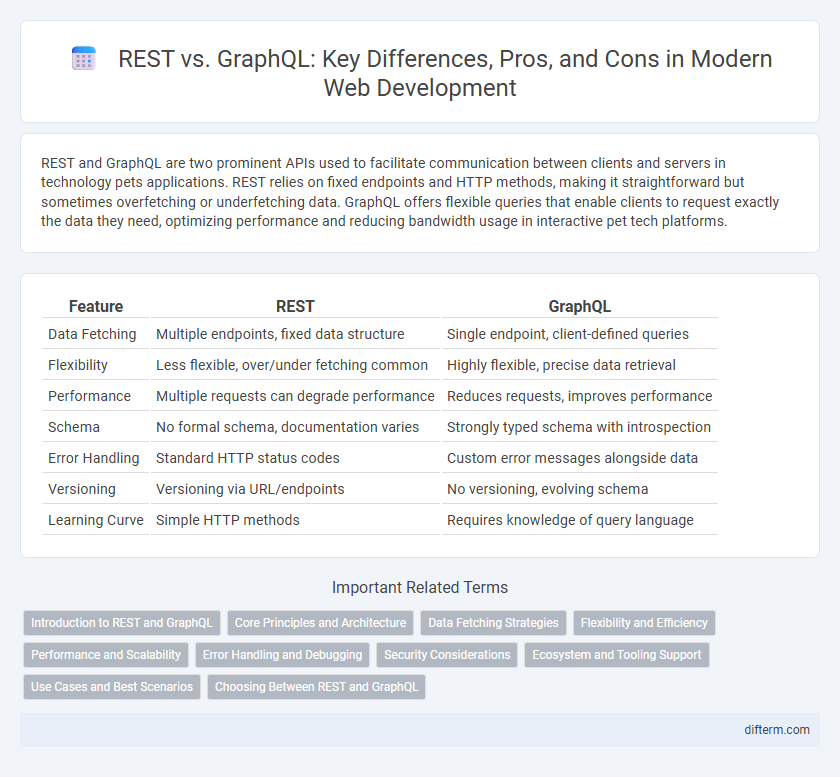REST and GraphQL are two prominent APIs used to facilitate communication between clients and servers in technology pets applications. REST relies on fixed endpoints and HTTP methods, making it straightforward but sometimes overfetching or underfetching data. GraphQL offers flexible queries that enable clients to request exactly the data they need, optimizing performance and reducing bandwidth usage in interactive pet tech platforms.
Table of Comparison
| Feature | REST | GraphQL |
|---|---|---|
| Data Fetching | Multiple endpoints, fixed data structure | Single endpoint, client-defined queries |
| Flexibility | Less flexible, over/under fetching common | Highly flexible, precise data retrieval |
| Performance | Multiple requests can degrade performance | Reduces requests, improves performance |
| Schema | No formal schema, documentation varies | Strongly typed schema with introspection |
| Error Handling | Standard HTTP status codes | Custom error messages alongside data |
| Versioning | Versioning via URL/endpoints | No versioning, evolving schema |
| Learning Curve | Simple HTTP methods | Requires knowledge of query language |
Introduction to REST and GraphQL
REST (Representational State Transfer) is an architectural style for designing networked applications that relies on stateless communication and standard HTTP methods like GET, POST, PUT, and DELETE to manipulate resources. GraphQL is a query language and runtime for APIs that allows clients to request exactly the data they need, improving efficiency and reducing over-fetching commonly seen in RESTful services. Both technologies serve to enable client-server communication, but GraphQL offers more flexibility and precise data retrieval compared to the fixed endpoints of REST.
Core Principles and Architecture
REST architecture relies on stateless communication and predefined endpoints, emphasizing resource-based interactions using standard HTTP methods like GET, POST, PUT, and DELETE. GraphQL provides a flexible query language that allows clients to request exactly the data they need, reducing over-fetching and under-fetching by encapsulating multiple resources into a single endpoint. REST's uniform interface contrasts with GraphQL's single endpoint approach, where schemas define data types and relationships, enabling dynamic queries and real-time updates.
Data Fetching Strategies
REST utilizes multiple endpoints to fetch fixed data structures, which can lead to over-fetching or under-fetching of information. GraphQL employs a single endpoint allowing clients to specify exact data fields, reducing payload size and improving efficiency. Optimizing data fetching strategies with GraphQL enhances flexibility and minimizes network requests compared to REST's rigid resource-based approach.
Flexibility and Efficiency
REST APIs follow a rigid structure with fixed endpoints, which can lead to over-fetching or under-fetching of data, reducing efficiency in handling diverse client requirements. GraphQL offers greater flexibility by allowing clients to specify exactly the data they need in a single query, minimizing network requests and improving performance. This dynamic approach enhances efficiency in modern applications by supporting fine-grained data retrieval and reducing server load.
Performance and Scalability
GraphQL enhances performance by allowing clients to request precisely the data they need, reducing over-fetching and minimizing server load compared to REST's fixed endpoints. REST can struggle with scalability due to multiple round-trips for nested resources, whereas GraphQL's single endpoint consolidates data fetching, improving efficiency in large-scale applications. Implementing GraphQL also supports better caching and batching capabilities, which further optimizes response times and resource utilization under high traffic.
Error Handling and Debugging
REST typically uses standard HTTP status codes for error handling, making it straightforward to identify common issues like 404 Not Found or 500 Internal Server Error. GraphQL, however, returns errors within the response body under the "errors" field, offering detailed error messages and allowing partial data to be returned alongside errors for more nuanced debugging. Tools like Apollo Client enhance GraphQL debugging by providing error tracking and performance analysis, while REST debugging often relies on traditional logging and HTTP monitoring tools.
Security Considerations
REST APIs rely on stateless communication and often use standard HTTP methods with built-in security features like OAuth and HTTPS, providing a straightforward approach to authentication and authorization. GraphQL, while flexible in querying, requires careful implementation of query complexity analysis and depth limiting to prevent over-fetching and denial-of-service attacks. Both technologies demand rigorous validation, proper rate limiting, and robust access controls to safeguard sensitive data and maintain secure interactions.
Ecosystem and Tooling Support
REST benefits from a mature ecosystem with extensive tooling, including robust libraries, widespread API documentation standards like OpenAPI, and broad compatibility with web frameworks and client applications. GraphQL offers powerful developer tools such as GraphiQL for query testing and introspection, alongside growing support in major platforms and libraries, enabling efficient data fetching and schema evolution. Both REST and GraphQL ecosystems continue to evolve, with REST excelling in legacy system integration and GraphQL advancing in real-time data and complex query handling.
Use Cases and Best Scenarios
REST APIs excel in scenarios requiring simple, standardized CRUD operations with predictable resource-based endpoints, making them ideal for public APIs and services with stable data structures. GraphQL is best suited for complex applications needing flexible queries and efficient data retrieval, such as mobile apps and dashboards where clients require customized responses and minimize over-fetching. Choosing between REST and GraphQL depends on factors like data complexity, client requirements, and performance considerations in dynamic data environments.
Choosing Between REST and GraphQL
Choosing between REST and GraphQL depends on the specific needs of the application, such as data-fetching efficiency and flexibility. REST offers simplicity with predefined endpoints and stateless communication, making it suitable for straightforward, resource-based APIs. GraphQL provides more precise queries and reduces over-fetching by allowing clients to request exactly the data they need, which is ideal for complex and evolving APIs.
REST vs GraphQL Infographic

 difterm.com
difterm.com